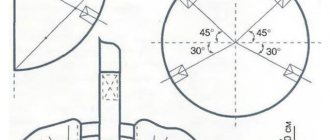Nowadays, every family dreams of having a country house far from the bustle and pollution of the city, where they can have a wonderful weekend, admire nature and enjoy life. Benches and cots are a thing of the past. Now preference is given to a special bed suspended on strong ropes from two trees (rarely independently constructed metal supports). The hammock originated in South America and was intended to allow one to sleep outside on hot nights without ants and all sorts of crawling creatures bothering one’s healthy rest.
Hammocks were especially popular among Spanish sailors. They are considered the suppliers of this device to European countries. The rocking bed, made of durable fabric, is compact and comfortable, and has certain relaxation abilities. Thanks to it, people not only relax, they relax, are filled with positivity, set themselves up to achieve their goals, and think about the future. Hammocks can be found everywhere: at the dacha, in the countryside, in the forest. They are an integral attribute of fishing and hiking. You can also find it in an ordinary apartment.
- Hammock for a summer house with frame
Types of hammocks
Before deciding on the rules for installing a hammock, you need to find out what types there are. Many companies produce such stocks, annually improving the models, making them more convenient, practical, and lightweight. Each product has a service life determined by the manufacturer. This criterion is worth paying attention to, but it is not the main one. Much depends on other parameters:
- Forms. Classic hammocks have a “boat” shape, convenient for relaxation. However, there are models in the form of tents, swings, and chairs. They may be accompanied by a footrest, canopy, mosquito net and other functional accessories.
- Type of fastening. The hammock is attached to the supports using metal rings. To do this, you need to have special devices on trees or installed stationary structures. The main thing is to have enough space to install it.
- Fabric base. As a rule, specimens are made from the material and are intended for lying indoors. In the fresh air, it is preferable to relax in a hammock made of canvas, strong mesh and other durable materials that are not afraid of moisture.
Before attaching the hammock, it is worth understanding whether the place you have chosen is correct. The site should be free, spacious, with a beautiful view of nature. The absence of constant direct sunlight and strong gusts of wind will be of no small importance. Comfortable conditions are necessary for rest and complete relaxation.
Pergola or gazebo frame
If your summer cottage has pergolas or gazebos with pillars with a diameter of at least 20 cm, located at a distance of about 3.5 m from each other, they will become ideal supports for a hammock. The roof will create natural shade and protect you from the sun's rays even on the hottest day.
Where to hang a hammock
If you choose trees as a support, then pay attention to their diameter. The trunk cannot be less than 15 - 20 centimeters in diameter, and the distance between trees must be at least four meters. Only these parameters will enable the structure to be reliable and the trees to be safe and sound. Moreover, the trees must be healthy, strong, without cracks, with long branches located above the ground at a height of at least a couple of meters. They will make it possible to securely secure the hammock and make it safe.
How to hang a hammock correctly
Helpful advice! With frequent use of the hammock, the ropes stretch, causing it to sag. When hanging, you need to remember this and install the fasteners slightly above the expected mark.
Iron pillars
To install a hammock you will need two iron posts with a diameter of 15-20 cm, metal fasteners and cement mortar. The pillars must be installed at the same distance as the wooden beams, holes for them must be dug in the ground at least a meter deep, and concreted. After the solution has hardened, you can attach the hammock in the usual way.
How to hang a hammock on a tree - mounting methods and knots
There are several ways to attach such a structure. The most commonly used and simplest method is to use a strong rope (rope). The rope must be strong and thick. Rings for fastening are included with the hammock. The number of ropes required is 2 pieces. They are threaded through rings and tied to trees.
The most standard method of fastening is a strong rope
There are several principles for tying ropes. Reliability will be determined by which node you choose for this. Let's focus on the main ones.
Bowline
Even an uninitiated person can master it. Before making a knot, the rope is tied around the tree trunk several times, after which the work ends with a control knot.
Running simple knot
First, take a rope and make a loop out of it, which is tied around the trunk. To avoid untying, the free end of the rope is inserted into the loop and tightened tightly.
Noose - noose
It resembles a slip knot, but the loop is open and is made at the long end of the rope. The loop is tied around the barrel and tightened under the load. If there is no proper load, you can simply tie it.
Video about knots that are suitable for a hammock:
Hammock slings
They resort to using slings if the tree trunk is very rough and there is a possibility of the rope rubbing together with the subsequent fall of the hammock. Or the trunk is very slippery and the hammock may soon end up on the ground, gradually sliding down the trunk. To prevent this from happening, you need to take parachute lines and use them to make two meter-long strips (wide). The ends of the ribbons are folded and then stitched. As a result, loops are formed.
Attaching a hammock with slings
The trunk is wrapped with these ribbons, a rope is inserted into the loops and a hammock is hung. When working, you need to resort to the help of a carabiner. Slings are taken, wrapped around the barrel, and fastened together with a carabiner. Then rings are attached to hang the hammock.
Stores also sell special slings for hammocks.
Detailed video instructions on how to hang a hammock:
Basic fastening rules
There are many types of hammocks, but the main rules for placing these structures contain a number of general provisions. It is important to adhere to them in order to protect your vacation from negative situations.
To install a hanging bed yourself, you need to take into account the following requirements:
- Check the reliability of the supports. Their role is played by special poles, swing holders, room walls or trees (forest, garden). The diameter of natural supports should not be less than 20–25 cm. The pillars should be deepened into the ground at least 1 m. If a stationary location is chosen, the bases of the pillars can be filled with concrete. Wooden or metal poles are coated with paint (anti-corrosion treatment).
- The portable swing holders used must be made of durable materials, and all connections in them must be securely fixed. Be sure to take into account the rule according to which the load on the supports can be reduced by increasing the sagging of the suspended lounger.
- The distance between the supports is traditionally 3 m. For manually installed supports, the distance is calculated using the following formula: add 30 cm to the length of the product. In cases where the product is attached to natural supports, the height of the fastening and the degree of tension vary. You can lower it lower and tighten it more. Or tie it higher and make the sagging stronger.
- The mounting height of this household item, according to standard rules, is determined to be 1–1.5 m. For a specific situation, more accurate calculations can be made: the height is equal to the distance between the supports, multiplied by 2 and divided by 3.
- The ropes used as fastening material must be thick and durable. Their diameter is not less than 8 mm. It is better to thread it through the eyelets (if the model allows this).
- For the base it is better to use natural fabrics. They adapt much more easily to the shape of the human body and allow it to breathe. Synthetic fabrics are lightweight, durable and inexpensive. However, they lack the benefits of natural materials. It is optimal to use tarpaulin or camouflage fabrics, mattress teak. It is advisable to change the fabric base every 2–4 years.
- A knitted (knotted, corded) hammock is preferable from cotton materials. They are pulled tighter in the knots and are more pleasant to the touch compared to nylon threads.
- In places of friction and fixation of the rope to the support, a clamp (cambric) is put on it. This is protection in the form of a nylon tube that has the necessary elasticity and flexibility.
How to hang a hammock in a country house without trees
It happens that at the dacha there are no trees of suitable size, or there are none at all. But if you don’t want to give up lazily lying in a hammock, you will need to invent other methods. For example, you can attach one anchor to the facade of the house, and put a pole opposite it. If the fence is high enough and strong enough, then one part of the hammock can be attached to it, and, again, a post can be dug under the second.
If you have a terrace or large gazebo, you can attach a hammock to its ceiling. If you don’t have the length to fit a whole hammock a couple of meters away, you can hang a special hammock swing or a hammock chair - they will require much more space and are often supported by one mount.
Are there no such opportunities? Then you can offer a few more options so as not to be left without a hammock at the dacha.
Hammock for a summer house with frame
Owners of suburban land plots do not always plant gardens. Many are content with front gardens, flower beds, and a vegetable garden. The absence of trees is not a reason to refuse to relax in a hammock. Instead of the classic version, you can use homemade or purchased designs. The best option is a “constructor”, consisting of many parts, which is assembled and disassembled, installed and transferred to a new location.
Prefabricated frame hammock
This design has many positive qualities:
- no need for additional supports;
- assembly and disassembly takes up to 10 minutes;
- mobility;
- compactness (can be disassembled, folded and stored in winter until warm days arrive).
There are also negative points that you should be aware of:
- high cost: such a frame costs from 10,000 rubles, and the average price tag for them is about 20,000 rubles;
- difficult to pick up broken parts;
- Requires a lot of space for installation.
If you have an ordinary hammock, free time and hands from the right place, then you can always make a frame with your own hands. It can be made from either wood or metal.
Here's an example of how to make a frame for a hammock out of wood (clickable image):
How to make a hammock frame with your own hands
Fence posts or outbuildings
If the height of the fence allows, the pillars of its two spans, converging at right angles, can be used as fastenings. This way, the space near the fence will be put to good use, and the hammock will have enough room to swing.
Be sure to look at what to plant along the fence.
How to hang a hammock on poles
In the absence of trees and the reluctance to spend a lot of money to purchase a structure, they resort to the help of poles. The distance between the supports and the height of the hammock suspension are pre-calculated - usually 4-4.5 m and 2.5 m, respectively.
Calculation of the height of the support based on the distance between the pillars
For the upcoming work you must have:
- high-quality cement;
- perforator;
- pliers and hammer;
- hooks - self-tapping screws;
- metal poles with a diameter of 20cm and a sufficient height for attaching a hammock.
Then we take the following steps:
- we decide on the site;
- we dig holes up to 1 m deep at a distance of the length of the hammock plus half a meter;
- we concrete the pillars and let the concrete harden well;
- we hang fastenings on poles;
- we attach the hammock.
As soon as the work is completed, do not immediately fall into the hammock. You need to make sure your actions are correct once again. To do this, one person must fall sharply into the hammock, and another, standing in close proximity to the structures, must look to see if the pillars are tilted or if the ropes are untied.
Wooden pillars
The distance between the logs should be 30 cm greater than the length of the hammock fabric. There are several mounting options.
- The simplest is to dig two wooden posts at least 1.5 meters deep and use them for fastening like trees. The difference is that the rope on the beams can be secured more efficiently using self-tapping screws.
- A more complicated method is to build a rectangular structure of four beams and horizontal crossbars located at the top. The attachment points can be placed in the upper corners of the resulting “rectangle”.
How to make your own hammock, see our instructions.
How to hang a hammock in an apartment: attaching it to the walls
Many people strive for comfort and reconnection with nature, even while in their apartment. When buying a hammock, few people think in advance about where and how to attach it. An incorrectly chosen location and poor-quality fastenings can lead to the destruction of the load-bearing structures of the room and subsequent major repairs. In order not to create problems and avoid negative consequences, you should follow these recommendations:
- The chosen place should be spacious and uncluttered, based on the fact that it is not easy to hang a hammock; it also has the ability to swing. Ideally, the distance between the walls should be 3-4 m (it is advisable to leave approximately 0.5-1 m to the right and left of the hammock to swing), and the ceiling height should be from 3 m. The height of the anchors for fastening should be approximately 1.8-2 m from the floor,
- Using a pencil, make marks on the walls taking into account how comfortable it will be for you to climb into the hammock.
- Holes are made in the wall to the length of the anchor bolts. To avoid overheating of the drill, you should first make the holes of a smaller diameter and then widen them.
- We clear the hole from dust and cement chips. You can use a flat screwdriver, a thin manicure file or another similar device for these purposes.
- Using a hammer, insert the anchor into the wall. Attach the hook to it and tighten the nut clockwise until it stops.
- We do the same with the second wall. We thread the rope through the hooks, make knots and hang the hammock.
Helpful information! Avoid installing hooks in wooden posts, pipes, or other fragile surfaces that will not withstand the load of the hammock with a person there.
Useful video instructions on how to hang a hammock in a house or apartment:
Briefly about the main thing
The hammock is suspended between two supports, which can be strong trees, part of a permanent building, or any other reliable support.
If there are no suitable supports on the site, you can create them yourself by digging two metal pillars at the required distance.
Hammocks can also be hung in an apartment. For this, anchor bolts with rings or hooks at the end are used, to which a hammock is tied with ropes.
It is best to hang a hammock chair or hammock swing on the balcony. They are smaller in size and are attached to the ceiling using the same anchor bolts.
How to hang a hammock on the balcony: mounting to the ceiling
If there is no other free space in the apartment, but you really want to relax in a hammock, you can allocate a balcony for this purpose. As a rule, there is not enough space for a full-fledged structure. Therefore, manufacturing plants have launched the production of hammocks - armchairs, hammocks - pears, which are attached not to the walls, but to the ceiling. Installation rules vary and depend on what material was used to make the mounting base.
Floor hammock chair
If there is a wooden beam on the ceiling, then the fastening is done in the manner of a swing (using two fastenings). The main point is to tie the knots so that the hammock does not break at the wrong moment. If you have a concrete or stone slab, it is possible to mount it with one hook. You need to drill one hole, drive an anchor bolt into it, screw a nut into it and attach a hook. Then a thick and strong rope is attached to the hook for hanging the hammock.
Attaching a compact hammock chair
Recommendations from experts! Before purchasing self-tapping screws for a hammock, consult with the seller. A significant load on the bolt can cause the hammock to fall and cause abrasions and injuries to a person.
Ceiling or ceiling beams
Typically, the ceilings of country houses are not designed for installing hammocks; this option can only be used if metal structures are built into the edges to enhance rigidity. You need to attach them to them or directly into the beam, if it is strong enough.
The technology is simple: install anchor rings, reinforce them with fastening nuts and hang the hammock. Before installation, assess the height and width of the room. It is advisable that there be 1.5 meters of free space to the floor and each wall.
Option for ceiling placement of hammock chairs
How to climb onto a hammock correctly
How to use a hammock correctly without causing injury to yourself? There are certain safety regulations that must be strictly followed. They are as follows:
- Approach the hammock with your back and sit in the middle. Straighten the hammock material so that its top is level with the person’s shoulders. Then lean back on the hammock and spread it underneath you.
- Lie down gently in the hammock without making any sudden movements. First the body is laid down, then the legs are thrown in. You will be in it like in a cocoon.
- In the hammock, you can carefully turn over and take a comfortable position. The main thing is that the design is reliable.
On beams
The height and diameters of the supports should be the same as in the previous case. To calculate the distance between them, add 30 cm to the length of the canvas. The frame can be sanded and stained to protect the wood and be decorative. Metal pipes - paint or use anti-corrosion impregnation.
Sequencing
- Bury the posts to a depth of at least half a meter and compact the soil around them. If the length of the pillars is more than two meters, the optimal depth is at least one meter. To strengthen the structure, concrete is poured into the bottom of the pit and beams are placed in it.
- Cement the site. The option with concreting is more reliable - the soil will not become soggy from rain.
Instagram @messykessi
Instagram @furnlovers
You can attach the fabric in the same way as on trees. Use knots or self-tapping hooks to hang the canvas between the posts. The second option is considered more reliable, since the rope can slide on the pole. So, you have a durable, permanent structure that will last for many years. It can be supplemented with a canopy in case of bad weather or a pergola - an openwork partition for growing flowering and decorative deciduous vines.
Hammock Greenhouse
Rules for using a hammock
In order for a recreational device to please you for a long time, to give you the opportunity to have a great time, completely rest, relax, and be filled with strength and energy for further achievements, it is necessary not only to hang the structure well, but also to properly operate it.
The basic rules for using a hammock are as follows:
- The hammock should be hung at such a distance as to avoid its contact with the ground. Otherwise, over time it will become dirty and will not be able to swing.
- When relaxing in a hammock, avoid smoking and using sharp objects. They can cause cuts and holes in the product, which will render it completely unusable.
- When purchasing a fabric hammock, it must be constantly dried and ventilated. Otherwise, fungus and mold will appear on the fabric.
- If the hammock is not going to be used for a long time, it must be removed, packed and placed in a warm and dry place for long-term storage. It would be nice to put anti-moth tablets in a fabric copy.
- Fabric hammocks can be washed at a temperature of 30 degrees. Otherwise he may sit down. If there are cross bars, the hammock can be washed by hand.
- When purchasing a mesh hammock, before using it, you should lay a thick blanket or blanket there. If this is not done, the entire body will be “covered” with a mesh.
- To protect against mosquitoes, flies, and beetles, use a mosquito net.
- If the tree trunk is slippery or too rough, and the attached rope can rub against the bark, you need to wrap the trunk with artificial leather or thick fabric.
Rafter-webbing suspension system
The finished hammock is equipped with slings (straps). They are a mandatory structural part of the product. Slings are a continuation of the product. The slings include connecting elements and grips:
- rope branches;
- links;
- hooks;
- rings;
- staples;
- carbines.
Slings (straps) are made of thick rope or belt. To create one of the common variants of the rafter-webbing system, a belt 8 m long is taken. Then it is divided into 4 segments. They can be equal in length or different. If the length is not kept the same for all segments, then equal sizes are set for paired straps.
A knot is tied on the carabiner.
An adjustment bar can be used. Then the installed product will receive an aesthetic appearance and become more convenient to use.
The belt is threaded in one direction and pulled out the other.
The belt is passed through the hole in the carabiner. Then it is inserted into the adjustment bar.
The end of the belt is brought out.
The end of the belt (tail) must be fixed.
This place is stitched with dense nylon thread. Sewn with small, dense stitches. You will have to sew 3 layers. Alternatively, you can install one metal rivet.
4 straps are constructed and attached to the rim (harness) on four sides with carabiners.
The slings are tied in pairs (on both sides) to a bar horizontally located between the branches of the trees. The distance between the slings should be 40–60 cm. The length of the straps can be adjusted, giving different configurations to this piece of furniture.
To customize the seat, the front straps are made longer and the rear straps shorter.
Rafter-webbing systems allow hanging loungers to be used as chairs and swings. This type of fastening is quite reliable and less labor-intensive. There is no need to carry out complex calculations or consult drawings in the smallest detail.
Conclusion
There are a lot of other designs of hammock stands on the Internet that can be implemented with skillful hands, including hammocks with a canopy, but these particular ones have already been tested and are recognized as successful. Without spending a lot of effort, money and time, you can really get a convenient mobile support for a hammock to the delight of the whole family.
Other, no less useful devices for relaxing in the lap of nature are in the section of small architectural forms. We also have an article on how to sew a hammock yourself. Hanging beds for indoors and outdoors are also interesting. And for those who like the most comfortable relaxation, hanging swings are more suitable, which you can also make with your own hands. The video shows how to set up a swing and a children's complex on the site.
Subscribe to our Telegram channel Exclusive posts every week
In the gazebo
If you have a gazebo in your garden, you can hang a hammock here. This combination will look very practical. This location is considered very appropriate, because you can enjoy your vacation, regardless of weather conditions. The roof of the gazebo will protect you from precipitation.
How to insulate a balcony?Vertical gardening of an apartment: how to do it right
- Dwarf conifers: types and benefits
Under the ceiling
A hammock under the ceiling will look beautiful. Such a solution will add exoticism and aesthetics to the interior. It is best to choose hammocks in the form of a net as they look much better.
Safety is important. You can place soft pillows or a sports mat under the hammock so that children do not get injured if they fall.
By the pond
A hammock near a pond will look beautiful. This could be a river or stream running through your yard. You can make a pond or pool yourself and hang a hammock nearby.
Water has calming properties, so such a vacation will have a more positive effect on your psychological state. If you're not afraid to experiment, hang a hammock over a pond.
In the recreation area in the country house
If you have a relaxation area in your home, you can install a hammock here. It will act as an unusual decor.
A hammock is the best option if you want to adhere to rigor in the interior. It will neutralize excessive pretentiousness. Such an element will look beautiful in a democratic interior.
Preparation
The hammock appeared in Europe thanks to the travels of Christopher Columbus, who, having visited the Bahamas, noticed that the locals hung hammocks between trees - this is how they slept. The sailors, having tried this type of rest, adopted it and used it on the ship, which was much nicer and more convenient than sleeping on hard shelves.
In the modern world, hammocks can be found in apartments, in country houses, and on camping trips. Due to the simplicity of the design and the ability to use it in various situations, a wide variety of such products have appeared.
Modern devices can be different in design, size and type of placement. If you want to make a hammock with your own hands, you need to have a good understanding of what exactly you have to deal with and what you should have with you. The most important point in preparation is choosing a specific product option and collecting everything necessary for the job. To make a hammock strong and reliable, you need to strictly follow all the instructions for its manufacture, correctly draw a drawing of the future product and implement it.
Material calculation and drawing
Depending on which version of the hammock design will be chosen for manufacturing, you should prepare the material and make a pattern. The most common options include a frameless hammock, as well as one created using weaving techniques.
For the first option, it is important to correctly calculate the dimensions of the material from which the hammock will be created. The optimal piece of fabric is 230x150 cm, which will ensure the convenience of the future design
When calculating the size of a future product, you should focus on the height of family members or those who can use it. The optimal length of the fabric cut will be the sum of the height of the tallest user of the hammock and 60 cm, which will ensure comfort from its use. Having drawn the pattern on the fabric, leaving allowances at the edges of 4 to 6 cm, you can begin sewing the product.
If a weaving method was chosen to create a hammock, then you need to choose the optimal weaving pattern that will not cause problems during the work process. For such a product, it is recommended to purchase thick threads, or you can find strong ropes or cords at home. The most common hammock knitting options are double crochet or garter stitch. Dimensions are calculated in the same way as with a frameless model, which allows you to create a comfortable, fairly deep design in which a person can fully relax without worrying about their safety.
Tools
To make a hammock with your own hands, you need to stock up on everything you need. The list of the most important devices and tools looks like this:
- sharp and strong scissors;
- tape measure or centimeter;
- sewing needle of the required size or sewing machine;
- durable material;
- strips for creating a frame for a future design;
- drill and drill bits;
- shovel or drill for installing hammock supports;
- a hammer, thanks to which you can secure the wicker base to the frame.
If a hammock will be created using knitting techniques, then you need to have the following tools and materials:
- hook or knitting needles of the required size;
- scissors;
- sewing needle;
- rope or strong thread for knitting;
- drill for attaching the hammock to the support;
- wooden battens for attaching a hammock;
- a shovel or drill, if the structure will be attached to a stationary base;
- battens to create a base for a hammock.
Selection and location requirements
It is recommended to place a hammock near an open body of water, a swimming pool, or in the far part of the garden. At the dacha, such a structure is usually hung in a gazebo, house, balcony, terrace or porch.
Features of choosing a place to install a recreation area in the country:
- to avoid sunburn or colds, it is important to choose a place without drafts or direct rays;
- the surface below is made smooth and clean - stones and snags are removed, holes are leveled;
- the place should be quiet, away from the road, transformers, garages, water pumps;
- the distance between trees for a hammock should be at least 3 m in order to prevent severe sagging of the canvas;
- The important thing is that the support is complete, without damage, with a diameter of 20 cm.
It is also important for better relaxation and comfortable rest to hang the structure in a place from which a beautiful, calming view can be seen. To prevent mosquitoes or other insects from interfering with your rest, you can equip the area with a mosquito net or a thick canopy.
How to make sure that it was secured safely?
Once the hammock is installed, there are a few things you need to check. Firstly, the distance between the sagging part of the hammock and the ground must be at least 40 cm . Secondly, look at the shape of the resulting structure. In the correct position it should resemble a banana .
And finally, try first sitting down in the middle of the hammock, then gradually move to a lying position, first placing your upper body and then your legs. If the hammock does not twist or fall to the sides, the job can be considered successfully completed.
If there are no suitable trees, then you can use a ready-made frame for a hammock. In this case, such aspects as fastening, tools and installation are already provided by the manufacturer. You just need to follow the instructions correctly. You can also make such a frame yourself from wood or metal.
Features of operation and care of the hammock
Once you have figured out how to hang a hammock correctly, do not forget about the operating rules and monitor its condition. Only careful handling will allow you to enjoy relaxing on a suspended bed for many years.
- Do not overload the structure with excessive loads.
- It is better to smoke and barbecue away from your vacation spot.
- To prevent the canvas from getting dirty on the ground, it is important to monitor the height of the structure and adjust it as necessary.
- Periodically, the hammock needs to be removed and washed. Purchased options always come with detailed care instructions.
- To protect the material from fading, it is better to place the hanging bed in the shade or build a canopy.
- In rainy weather, you should try to protect the material from water and dry it as necessary.
- For the winter, it is important to store the hammock in a warm, dry place.
A hammock can be a great place to relax at home or in the country. In order for a hanging stock to last for many years, it is important to install it correctly and handle it with care.











